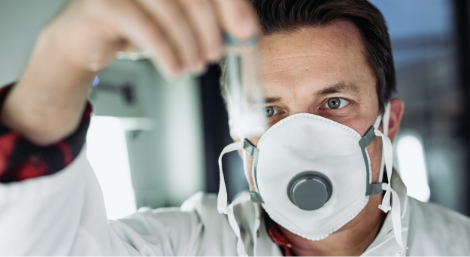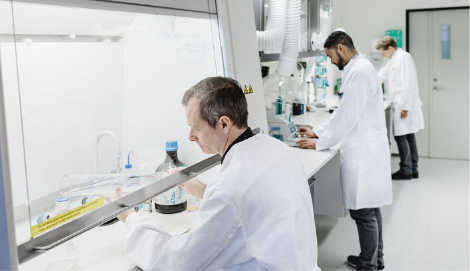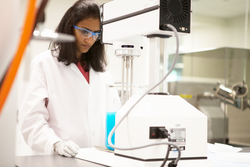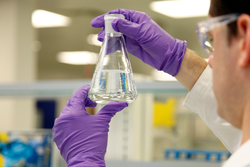
Ferring Pharmaceuticals’ largest R&D center
- Global Drug Discovery
- Pharmaceutical Development
- Clinical Development
- Global Regulatory Affairs
- Patient safety
- Transparency

Global Drug Discovery
Drug Discovery and Early Clinical Development is a branch of science in pharmaceutical research and development where new drug molecules are generated and tested with the aim to provide new treatment options for patients. The process normally starts with a concept or an idea and it goes to a feasibility assessment to identified chemical or biological starting points that have drug like properties. These are then rigorously tested in a series of experimental preclinical and clinical studies, initially in healthy volunteers and small patient groups, for efficacy and safety evaluation. The successful compound will further progress into full clinical evaluation and regulatory registration before the drug becomes available commercially.
Ferring runs its Drug Discovery and Early Clinical Development activities within a global organization, operating from two main R&D sites in Copenhagen, DK, and San Diego, US, where highly specialized multi-disciplinary scientists work together with the mission to discover transformational medicines. The functions involved are: chemistry, biotherapeutics, biology, bioinformatics, immunology, toxicology, pharmacokinetics, translational and clinical pharmacology. The scientists are supported by a global team of External Innovation and Scientific Licensing to enable collaboration and advancing the best science.
The organization’s main focus is in the therapeutic areas of Fertility and Maternal health, Gastroenterology and Uro-oncology.

Pharmaceutical Development
Pharmaceutical Development turns potential drug molecules into products that are tested in clinical trials for their efficacy and safety and that are suitable for commercial scale manufacturing & supply.
The main Pharmaceutical R&D tasks are:
- To develop a scalable manufacturing process of the pharmaceutical active molecule. Depending on the nature of the molecule that can be a chemical synthesis for small molecules, or a biotechnological process using genetically modified organisms for complex molecules such as proteins.
- To formulate the pharmaceutical active molecule to ensure its stability and to develop the right dosage and delivery system to ensure the delivery of the drug to the right part of the body in the most convenient way for the patient. Typical examples of delivery systems are tablets, syringes or complex devices like implants, injector pens etc.
- To develop a commercially suitable manufacturing process for the final drug product and to provide analytical methods for its quality control.

Clinical Development
Once reaching the clinical phase, the drug candidate has now advanced to the clinical testing in humans, which traditionally takes five to seven years. The testing is divided into 3 phases:
- In phase I, the drug tested in healthy volunteers starting with very small doses followed by higher doses until they are expected to be effective in patients. The safety and tolerability of the drug are assessed, and pharmacokinetic evaluations are performed.
- In phase II, the drug is tested in few patients and the effect on the target disease is evaluated. In addition, the dosing of the drug and the safety in patients are investigated.
- In phase III, the findings from phase II are confirmed in a large patient population. The purpose is to demonstrate efficacy and safety in statistically robust, unbiased studies, which usually include several hundred patients from many hospitals in several countries, and the trials are traditionally controlled and double-blind. We co-operate with more than 1,000 investigators worldwide to conduct the trials.
After successful phase III studies, the drug may obtain marketing authorization, and is usually further investigated in several phase IV trials to define the exact role of the drug in treatment of diseases.
In all phases, the toxicity of the drug is investigated and documented. It is also investigated how the administration of the drug interacts with physiological processes, including building knowledge on how the drug is absorbed, distributed, metabolized and excreted. This is paramount knowledge for documenting the clinical efficacy and safety of the new drug.

Global Regulatory Affairs
Throughout the drug development process, from early discovery through launch of a product, regulatory affairs provide input and strategies to ensure that the data and documentation generated are tailored to suit a successful registration by the various health authorities worldwide. Our regulatory affairs department analyze and compile documentation from the clinical and non-clinical studies, quality data and the manufacturing process.
This documentation is electronically submitted to the regulatory authorities for assessment after which – if the data are found to be sufficient to prove the drug’s quality, efficacy and safety – Ferring is granted marketing authorizations.
After approval and launch of the new product, the regulatory activities continue; Changes in the manufacturing process, new indications, new pharmaceutical formulations or additional safety information require approval from the regulatory authorities. Similarly, changes in the labelling, approval in new markets require approval from the regulatory authorities.

Patient safety
Throughout the life-cycle of Ferring products, we continuously provide up-to-date information regarding benefits and risks of our products, based on information from many sources such as preclinical and clinical trials, case reports from healthcare providers, consumers, literature and quality complaints.
International and national legislation regulate the field strictly. Ferring is in compliance with the requirements and we maintain a constant and focused safety surveillance of our products in all markets. Regulatory authorities are continuously kept informed about our evaluations and activities to sustain their confidence in Ferring products.

Transparency
Below you can download our annual transparency reporting as per Ferring Pharmaceuticals A/S membership of ENLI in Denmark. These include the below listed reporting types:
Grants and donations to Danish hospitals and science units
Collaborations with Patient Organisations
We are always looking for talented new colleagues. If you have skills, knowledge and interests within any of the various areas of the Pharmaceutical Research and Development phases and our products or interest within any of our other functional and business areas, please do not hesitate to apply for the available job openings in Denmark as well as Ferring worldwide
https://www.ferring.com/en/working-at-ferring/job-openings/
Please note that due to the General Data Protection Regulation (GDPR) unfortunately we do not receive unsolicited applications.

